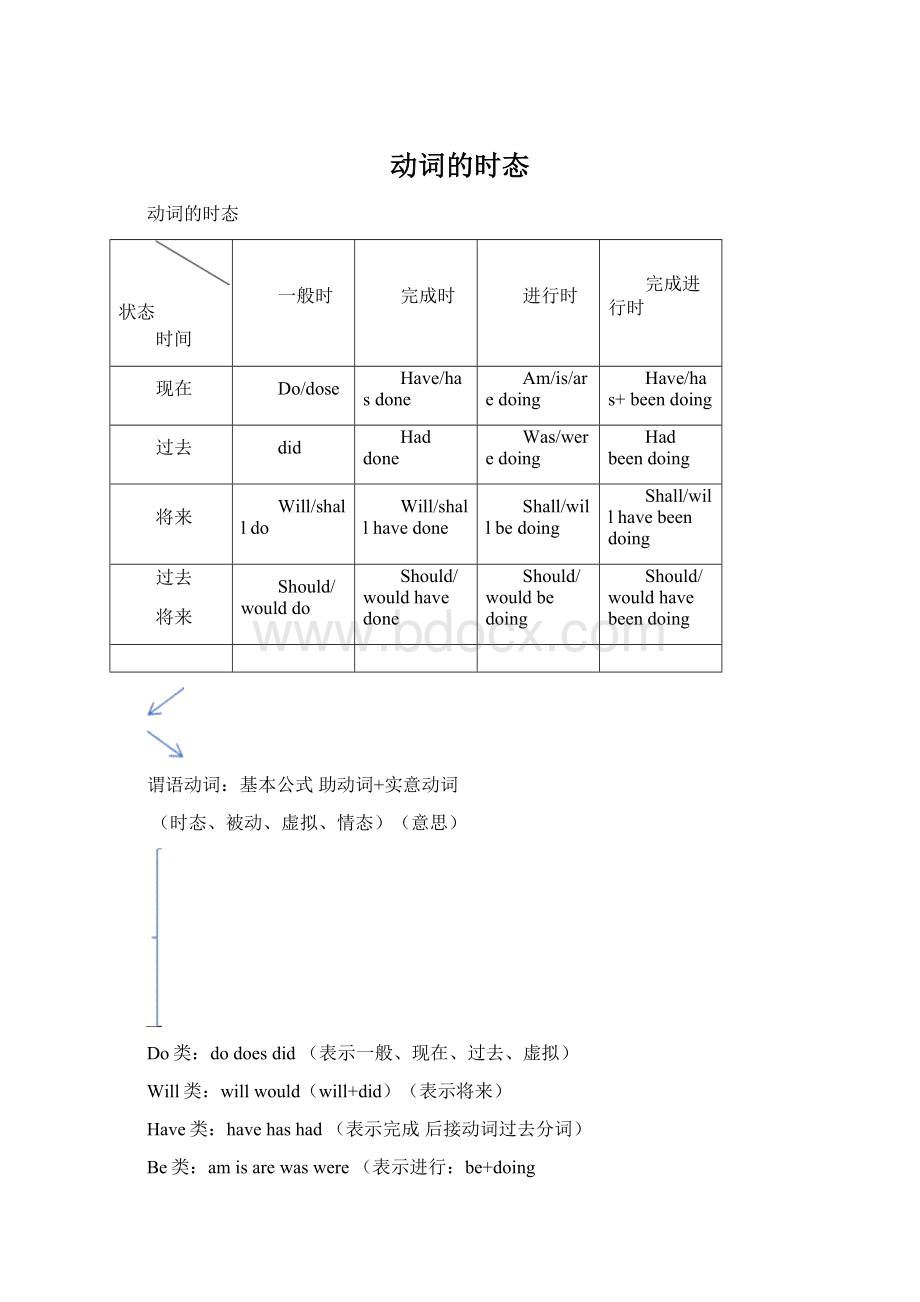动词的时态.docx
《动词的时态.docx》由会员分享,可在线阅读,更多相关《动词的时态.docx(15页珍藏版)》请在冰豆网上搜索。

动词的时态
动词的时态
状态
时间
一般时
完成时
进行时
完成进行时
现在
Do/dose
Have/hasdone
Am/is/aredoing
Have/has+beendoing
过去
did
Haddone
Was/weredoing
Hadbeendoing
将来
Will/shalldo
Will/shallhavedone
Shall/willbedoing
Shall/willhavebeendoing
过去
将来
Should/woulddo
Should/wouldhavedone
Should/wouldbedoing
Should/wouldhavebeendoing
谓语动词:
基本公式助动词+实意动词
(时态、被动、虚拟、情态)(意思)
Do类:
dodoesdid(表示一般、现在、过去、虚拟)
Will类:
willwould(will+did)(表示将来)
Have类:
havehashad(表示完成后接动词过去分词)
Be类:
amisarewaswere(表示进行:
be+doing
表示被动:
be+done)
“变态”
时态:
时间过去现在将来过去将来
状态一般进行完成完成进行
被动
虚拟:
白纸黑字说瞎话
情态:
“情感色彩”(推测、命令、请求、能够)
例:
写出employ的过去将来完成进行时的被动语态
Did+will+have+be+be+实意动词
Wouldhavebeenbeingemployed
ItoldhimthatIwouldnothavebeenbeingemployed3yearsbythiscompanyuntiltheendofthisyear.
第一节一般现在时
1.概念:
经常、反复发生的动作或行为及现在的某种状况。
2.时间状语:
always,usually,often,sometimes,everyweek(day,year,month…),onceaweek,onSundays
3.基本结构:
动词原形(如主语为第三人称单数,动词上要改为第三人称单数形式)
4.否定形式:
am/is/are+not;
谓语动词为行为动词(eat/think):
前加don't,
主语为第三人称单数:
前加doesn't,并还原行为动词。
Eg.Ithinkyouareright.--------Idon'tthinkyouareright.
Hethinksyouareright.-------Hedoesn'tthinkyouareright.
5.一般疑问句:
be动词在句首,用助动词do提问;
如主语为第三人称单数,用助动词does,并还原行为动词。
6.例句:
(1)表示经常性或习惯性发生的动作。
Wehavethreemealsaday.
Hegoestothecinematwiceamonth.
(2)表示客观事实,真理和自然现象。
Knowledgeispower.
Themoonrunsaroundtheearth.
(3)表示现在的情况或状态。
IliveinBeijing.
(4)表示按时间表,计划,规定将要发生的动作。
Thetrainarrivesat10.30.Thereisplentyoftime.
OurtripstartsfromXi'anandfinishesupinHuangshanMountain.
(6)在时间状语从句和条件状语从句中,用一般现在时代替一般将来时。
状语用来修饰谓语动词,说明地点、时间、原因、结果、条件、方向、方式、伴随等
Ifyouarrives,pleasgivemeaphonecall.
Aslongasitdoesn'traintomorrow,wewillhaveatriponschedule.
第二节一般过去时
1.概念:
过去某个时间里发生的动作或状态;过去习惯性、经常性的动作、行为。
2.时间状语:
ago,yesterday,thedaybeforeyesterday,lastweek,last(year,night,month…),in1989,justnow,attheageof5,oneday,longlongago,onceuponatime等
3.基本结构:
be动词过去式/行为动词的过去式
4.否定形式was/were+not/行为动词前加didn't,并还原行为动词。
5.一般疑问句:
was或were在句首/用助动词did提问,并还原行为动词。
6.例句:
(1)表示过去发生的动作或存在的状态
Theylivedherefortwentyyears.
Couldyoupleaserepeatyouraddress?
Ididn'tquitecatchit..
(2)表示过去经常性或习惯性动作
这时常常与always/usually/often/never等时间状语连用
Ineverdrankcoffee.
Ialwaysgotuplate,andneverhadenoughtimeforbreakfast.
(3)表示过去将来的动作
在条件状语从句中,用一般过去时代替将来的动作。
ShewouldcomeifIpromisedtowaitforher.
Shesaidassoonasshearrived,shewouldringmeup.
第三节一般将来时
1.概念:
表示将要发生的动作或存在的状态及打算、计划或准备做某事。
2.时间状语:
tomorrow,nextday(week,month,year…),soon,inafewminutes,by…,inafewdays,sometime,etc.
3.基本结构:
(1)will/shall+do.即将发生的动作、状态
Eg.Whatshallwedo?
Willyoubefreethisevening?
(2)Be+goingto+do表示计划、安排好的事/有迹象表明肯定要发生的事
Eg.Thereisgoingtobeanmeetingthisevening.
Lookattheblackcloudsoverthere.Ithinkitisgoingtorainsoon.
(3)Be+to+do表示常规性活动/注定要做的事
Eg.Whoistocleantheclassroomtoday?
【注意】
Iamtobeanengineer.时间上更快一点,更有把握
Iamgoingtobeanengineer.主观愿望
(4)Be+about+todo马上要做(时间最短,不强调主观性,一般不加具体的时间状语)
Eg.Bequiet!
Theconcertisabouttostart.
(5)Be+现在分词表示将要发生的动作或状态(主要是瞬间动词:
come,go,leave,arrive,begin,start,stop,close,die,join,borrow,buy等)
Eg.I’mcoming.
Thedogisdying.
4.否定形式:
will/shall+not;be+not
5.一般疑问句:
be放于句首;will/shall提到句首。
~~~~~~~~~~~~~~~~~~~~~~~~~~~~~~~~~~~~~~~~~~~~~~~~~~~~~~~~~~~~~~~~~~~~~~~~~~~~~~~~~~~~~
第四节现在完成时
1.概念:
过去发生或已经完成的动作对现在造成的影响或结果,或从过去已经开始,持续到现在的动作或状态。
2.时间状语:
recently,lately,since…for…,inthepastfewyears,etc.
3.基本结构:
have/has+done
4.否定形式:
have/has+not+done.
5.一般疑问句:
have或has
特殊疑问句:
A.疑问词(主语)+have/has+过去分词
Whohas/haveboughttheseapples?
B.疑问词做主语以外其他成分
Howlonghaveyoulivedhere?
6.意义:
形式
用法
意义
接时间状语
Have/has+过去分词
继续
表示从过去继续到现在的动作或状态
Since,for,Howlong…?
all
经验
表示过去某时刻到现在的经验
Often,ever,never,before,once,…..times
完成
表示现在刚完成的动作
Already,just,yet
结果
表示现在是“做了…..”的结果
不需要时间状语
(1)表示继续
表示过去的动作一直延续到现在,并且会持续下去。
IbegantostudyEnglishthreeyearsago.
IstillstudyEnglishnow.Mygrandfatherhasworkedherefornearly30years.
IhavestudiedEnglishsincethreeyearsago.
Hehasbeensickalltheday.
Ihavebeeninthelibraryforawholemorning.
(2)表示经验
Helenreadthenovelthreeyearsagoandshereadthenovelagainandagain.
NowHelenknows(remembers)thenovel.
Helenhasreadthenovelthreetimes.
IhavevisitedTokyotwice.
HaveyoubeentoHawaii?
(3)表示完成(说话前已完成的动作)already,yet,just,bythistime,sofar
Ihavejustfinishedmyhomework.
(4)表示结果(过去的动作对现在仍有影响)
Iopenedthedoor.
Thedoorisopennow.Ihaveopenedthedoor.
Ihavelostmydictionary.
(5)和最高级连用,表示到现在为止是最……的
Whataboringfilm!
It'sthemostboringfilmI'veeverseen.
ItisthethickestbookI'veeverread.
(5)和句型Thisisthefirsttime…,It'sthefirsttime连用
Thisisthefirsttimehehasdrivenacar.(=Hehasneverdrivenacarbefore.)
Isthisthefirsttimeyou'vebeeninhospital?
ProfessorJohnsonhaslosthispassportagain.It'sthesecondtimehehaslostit.
7.【注意】
(1)在时间,条件状语从句中用现在完成时表示将来完成的意义。
Don'tgetoffthebusuntilithasstopped.
Onceyouhavepromised,youmustkeepit.
(2)just和justnow都可以译成“刚才”,
justnow一般用于过去时,在句尾Eg.WehadanEnglishlessonjustnow.
just用于现在完成时,在句中Eg.WehavejusthadanEnglishlesson.
(3)几种时态表示一种意思
HeleftChinatwoyearsago.
ItistwoyearssinceheleftChina.
HehasbeenawayfromChinafortwoyears.
第五节过去完成时
1.概念:
以过去某个时间为标准,在此以前发生的动作或行为,或在过去某动作之前完成的行为,即过去的过去
2.时间状语:
before,bytheendoflastyear(term,month…),etc.
3.基本结构:
had+done.
4.否定形式:
had+not+done.
5.一般疑问句:
had放于句首。
6.例句:
Ihadjustfinishedhalfoftheworkbyyesterday.
Shealreadyknewthesecretbutnoonehadtoldher.
vhardly/scarcely/rarely……when…….
vNosooner……than…….
过去完成时,一般过去时
v当hardly和nosooner位于句首时,要用部分倒装。
Eg.ScarcelyhadRosaheardthenewswhensheburstintotears.
Nosoonerhadthebellrungthanthestudentsrushedout.
【注意】
(1)主句为过去时的宾语从句,从句常用过去完成时。
Eg.Hesaidhehadbeenasoldier.
Theysaidtheyhadseenthefilmbefore.
(2)expect,hope,suppose,think,want等词的过去完成时表示未实现的计划、打算或希望。
Eg.Ihadhopedtoseeyou.=Ihopedtohaveseenyou.
HewantedtobuyahouseinBeijing.=HewantedtohaveboughtahouseinBeijing.
第六节将来完成时
1.概念:
在将来某一时刻之前会完成的动作或状态并对将来某一时间产生影响。
2.时间状语:
bythetimeof;bytheendof+时间短语(将来);bythetime+从句(将来)
3.基本结构:
begoingto/will/shall+havedone
4.例句:
Weshallhavefulfilledtheworkbytheendofnextweek.
第七节过去将来完成时
1.概念:
以过去某一时间点为参照,表示到这一时间点为止将会完成的动作。
2.结构:
should/wouldhavedone.
3.例句:
Hetoldmehewouldhavelearned4000Englishwordsbytheendoflastmonth.
Shesaidshewouldhavefinishedherexamsbythen.
Heknewbythetimehearrivedshewouldhavegonehome.
~~~~~~~~~~~~~~~~~~~~~~~~~~~~~~~~~~~~~~~~~~~~~~~~~~~~~~~~~~~~~~~~~~~~~~~~~~~~~~~~~~~~~
第八节现在进行时
1.概念:
表示现阶段或说话时正在进行的动作及行为。
2.时间状语:
now,atthistime,thesedays,etc.
3.基本结构:
am/is/are+doing
4.否定形式:
am/is/are+not+doing.
5.一般疑问句:
把be动词放于句首。
6.例句:
(1)表示说话时正在进行的动作状态
Itissnowinghardoutside.
(2)表示现阶段正在进行的动作,但说话时未必正在进行
Iamteachingpart-timeinamiddleschool.
(3)表示马上就要发生,非延续性动词用于进行时态,往往表示“马上就,即将,逐渐的,反复的”等意思
I’coming.
Someoneisknockingatthedoor.
(4)表示一种情感色彩(赞赏/厌烦)
Iamalwaysforgettingthings.
Sheisalwayshelpingotherswhentheyareintrouble.
第九节过去进行时
1.概念:
表示过去某段时间或某一时刻正在发生或进行的行为或动作。
2.时间状语:
atthistimeyesterday,atthattime或以when引导的谓语动词是一般过去时的时间状语等。
3.基本结构:
was/were+doing
4.否定形式:
was/were+not+doing.
5.一般疑问句:
把was或were放于句首。
6.例句:
Atthatmoment,wewerehavingdinnertogether.
7.过去进行时和一般过去时连用,表示在一个动作发生的过程中,发生了另一个动作
ItwasrainingwhenIgotup.
IfellasleepwhenIwaswatchingtelevision.
第十节将来进行时
1.概念:
指从现在算起的将来某一点时间正在进行的动作或将要进行的动作。
2.结构:
shall/willbedoing
3.例句:
ThistimetomorrowwewillbeflyingtoParis.
第十一节过去将来进行时
1.概念:
表示过去某一时间之后的将来某一时间正在发生的动作。
2.结构:
should/wouldbedoing
3.例句:
Hesaidthathewouldbewaitingformeoutside.
第十二节现在完成进行时
1.概念:
在过去某一时刻之前开始的动作或状态一直持续到说话为止
2.基本结构:
have/has+been+doing
3、例句:
(1)表示动作从过去某一时间开始一直延续到现在或离现在不远的时间。
Mybabyhasbeensleepingthewholemorning.
(2)表示刚才,近来发生的动作,一般不再延续。
Myhandsaredirty.Ihavebeencleaningtheroom.
(3)表示带有强烈的感情色彩
Youknow,youreallyhavebeenmakingthingsdifficultforhim.
(4)表示动作重复性
Youhavebeenaskingthesamequestionthesedays.
第十三节过去完成进行时
1.概念:
指从“过去的过去”某一时间点开始的动作或状态,一直延续到过去。
2.基本结构:
had+been+doing
3.例句:
Iwastired.Ihadbeenworkingsincedawn.
Ithadbeensnowingallnight.Thegroundwaswiththicksnow.
▲【不能用于进行时的动词】
感官动词:
hear,see,notice,feel,taste等
表示态度,感情的动词:
like,lovehate,desire,wish,mind,appreciate,fear,envy等
表示心理状态的动词:
know,realize,understand,recognize,believe,feel,want,expect,prefer
表示存在状态和持续的动词:
seem,look,owe,weigh,be,exist,continue等
表示占有的动词:
have,belongto,possess等
v如果hear不表示“听见”而表示“听”的意思时,可用于进行时。
Doyouhearthenoiseofaplane?
TheyarehearinganEnglishlecture.
v如果have/has表示吃饭,开会,玩的愉快等的意思时,可用于进行时。
Iwashavingdinnerwhenyoucalledmeup.
【总结】
一般现在时:
经常...老做某事(强调永恒性、真实性、反复性)
一般过去时:
当时...(强调动作当时的时间、地点、人物、方式)
现在完成时:
已经...(不强调动作本身,只强调结果、影响)
我八点吃的早饭。
(一过)我吃过早饭了(现完,强调现在不饿了)
过去完成时:
过去的过去(找参照物)
进行时:
强调时间点上的动作政治进行,未完成
表达强烈的情感“总是”Myfatherisalwaysbeatingme.
现在完成进行时:
一个动作到现在为止进行了一段时间/已经做了一段时间且还在做
过去完成进行时:
一个动作到过去为止进行了一段时间/已经做了一段时间且还在做
例:
我已经学英语8年了现在完成进行havebeenlearning
一般将来时:
一现表将来时间表:
车、船、飞机、上课、开始营业
时间状语从句、条件状语从句
祈使句+and/or+一般将来时
五、课后作业
1.Wehaven’tmet(meet)ournewneighborsyet,sowedon'tknowtheirnames.
2.---Whatwouldyoudoifitrains(rain)tomorrow?
---Wehavetocarryiton,sincewe'vegoteverythingready.
3.Thehero'sstoryisreported(report)differentlyinthenewspapers.
4.Thecoffeeiswonderful!